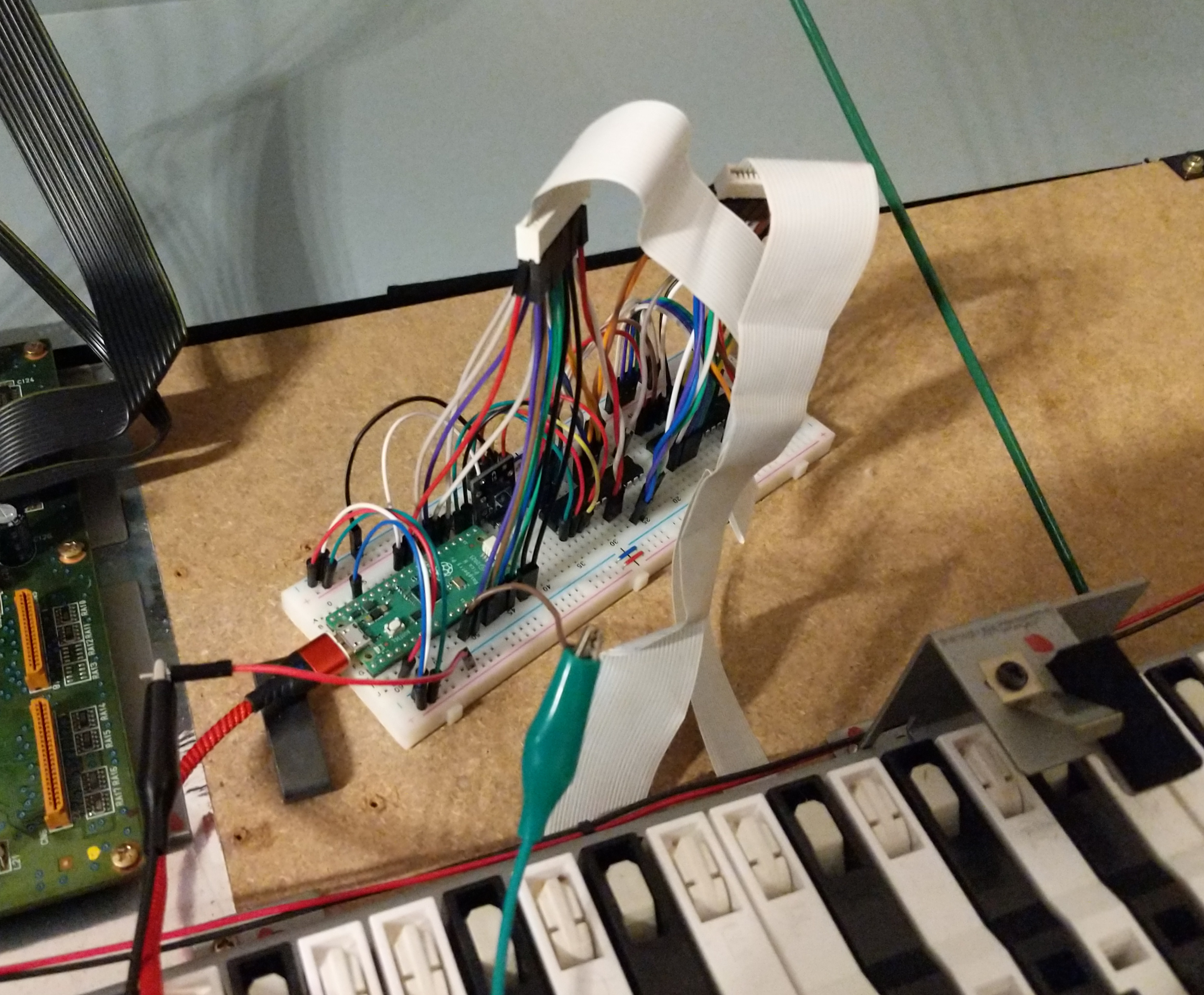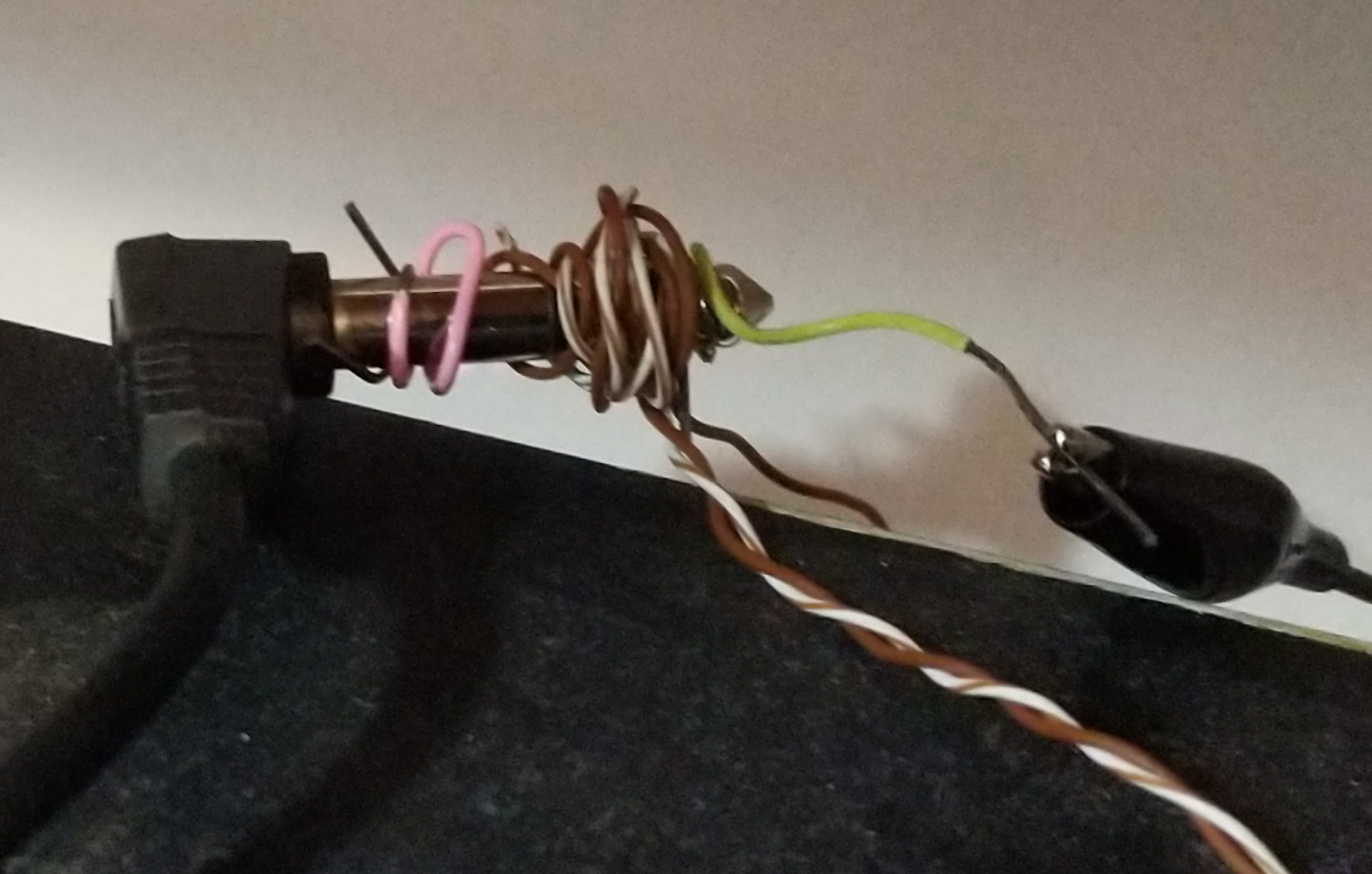199 lines
8.5 KiB
Markdown
199 lines
8.5 KiB
Markdown
# geode-piano
|
|
|
|
Digital piano firmware for the Raspberry Pi Pico.
|
|
This project only attempts to expose the keyboard as a MIDI device.
|
|
The purpose is to revive digital pianos that have working keys, but faulty electronics.
|
|
|
|
Here is a demo of Geode-Piano, where I play a bit from Lacrimosa:
|
|
|
|
<video controls width="640" height="360" type="video/mp4">
|
|
<source src="https://raw.githubusercontent.com/dogeystamp/geode-piano/main/.assets/demo.mp4">
|
|
Your browser does not support the video element.
|
|
</video>
|
|
|
|
https://github.com/dogeystamp/geode-piano/assets/61116261/2a5f732a-5d3e-4b5f-9467-373fa84dd736
|
|
|
|
## features
|
|
|
|
- 88-key piano
|
|
- Key matrix pin layout scanner
|
|
- (Basic) velocity detection
|
|
|
|
## installation
|
|
|
|
- Follow the materials and wiring sections below.
|
|
- Clone project.
|
|
- Go into project directory.
|
|
- Install the `thumbv6m-none-eabi` target using rustup.
|
|
|
|
You now have two choices for installation.
|
|
You can either use a debug probe such as the [Raspberry Pi Debug Probe](https://www.raspberrypi.com/products/debug-probe/), or install over USB.
|
|
The debug probe is more convenient
|
|
for iterating quickly,
|
|
but is harder to set up.
|
|
|
|
### no debug probe
|
|
- Install `elf2uf2-rs`.
|
|
- Set `runner = "elf2uf2-rs --deploy --serial"` in `.cargo/config`.
|
|
- Set the Pico into BOOTSEL mode:
|
|
- Hold down the BOOTSEL button on the Pico. Keep holding it during the following step.
|
|
- Reset the Pico: either replug the power, or short Pin 30 (RUN) to GND through a button or wire.
|
|
- Mount the Pico's storage on your device.
|
|
- `cargo run --release --bin [binary]`
|
|
- `[binary]` can be any binary under `src/bin/`. Run `cargo run --bin` to list them.
|
|
|
|
### with debug probe
|
|
|
|
- Install `probe-rs-tools` (`cargo install probe-rs-tools --locked`).
|
|
- Follow the wiring instructions in the [Pico Getting Started Guide](https://datasheets.raspberrypi.com/pico/getting-started-with-pico.pdf), at _Appendix A: Using Picoprobe_ in the Picoprobe Wiring section.
|
|
You only need to wire GND, SWCLK and SWDIO.
|
|
- If you are using a second Pico as a debug probe,
|
|
you must use a second USB data wire to communicate with both the debug probe and the geode-piano board.
|
|
- `cargo run --release --bin [binary]`
|
|
- `[binary]` can be any binary under `src/bin/`. Run `cargo run --bin` to list them.
|
|
|
|
If you are missing dependencies, consult [Alex Wilson's guide](https://www.alexdwilson.dev/learning-in-public/how-to-program-a-raspberry-pi-pico) on Rust Pico development.
|
|
|
|
Note that essential program output (e.g. pin scanner output)
|
|
goes through Embassy's USB serial logger rather than the defmt log that the debug probe has access to.
|
|
To see this output, install picocom and run
|
|
|
|
```
|
|
sudo picocom -b 115200 /dev/ttyACM0
|
|
```
|
|
|
|
changing `ttyACM0` to whichever serial device your Pico may be using.
|
|
|
|
## usage
|
|
|
|
The intended usage is to first plug the device into the piano keyboard, then use the `pin_scanner` binary to
|
|
scan the key-matrix. (See the next sections on how to wire it up.)
|
|
On every key, press it down half-way and then fully and note the pins connections detected at each level.
|
|
These correspond to the [`midi::KeyAction::N1`] and [`midi::KeyAction::N2`] actions respectively.
|
|
Use this format:
|
|
```
|
|
[note name] [GND pin]
|
|
[n1 input pin]
|
|
[n2 input pin]
|
|
```
|
|
There should be two switches per key for velocity detection.
|
|
If there isn't, then the key is an [`midi::KeyAction::N`] (it will be stuck at a fixed velocity).
|
|
Note names are in the format `C4, CS4, D4`, and so on.
|
|
|
|
The keymap is an array with the same dimensions as the matrix grid.
|
|
This is comprised of N1, N2, and N entries, indicating which note a key corresponds to.
|
|
Use `src/midi/keymap.py` to generate this boilerplate based on the pins noted down.
|
|
|
|
Either modify `src/bin/piano_firmware.rs` to fit your configuration, or copy it to a new source file.
|
|
Copy the keymap, as well as the `col_pins` and `row_pins` generated into this.
|
|
|
|
Once the keymap is done, run the `piano_firmware` binary and plug the USB cable to your computer.
|
|
Open up a DAW and select Geode-Piano as a MIDI input device.
|
|
If you don't need a full DAW, you can use `qsampler` with, for example, the [Maestro Concert Grand v2](https://www.linuxsampler.org/instruments.html) samples.
|
|
You should be able to play now.
|
|
|
|
Optionally, you can also hook up a speaker to the computer for better sound quality.
|
|
|
|
## materials
|
|
|
|
- 1 Raspberry Pi Pico (preferably with pre-soldered headers)
|
|
- 2 MCP23017 I/O extender chips, DIP format
|
|
- 2 pull-up resistors for I²C (1-10kΩ), these are optional but [recommended](https://www.joshmcguigan.com/blog/internal-pull-up-resistor-i2c/)
|
|
- 1 USB to Micro-USB cable with data transfer
|
|
- Ribbon cable sockets. The following is for my own piano, yours might be different:
|
|
- 18-pin 1.25mm pitch FFC connector
|
|
- 22-pin 1.25mm pitch FFC connector
|
|
- Many jumper cables (40 male-to-female, ? male-to-male)
|
|
- Two alligator clips
|
|
- Breadboard
|
|
- (optional) 1 debug probe, could be a second Raspberry Pi Pico
|
|
- and necessary wires to use it, for example
|
|
- 3-pin JST-SH cable
|
|
- data micro-USB to USB cable
|
|
|
|
For the ribbon cable sockets, open up your piano and find the ribbon cables.
|
|
Unplug them from the PCB, and count the amount of pins on them.
|
|
Also, measure the distance between each pin,
|
|
or the distance between the first and last pin.
|
|
This will help you find the right pin pitch and pin count.
|
|
Usually, these measurements can be found on the datasheets for FFC sockets.
|
|
|
|
## wiring
|
|
|
|

|
|
|
|
**Ensure all wires, especially GND and power wires, are well plugged in every time you use this circuit.**
|
|
|
|
### rails
|
|
|
|
- Pin 3 -> GND rail
|
|
- Pin 36 (3V3OUT) -> power (positive) rail
|
|
- Connect rails on each side to each other (GND to GND, power to power)
|
|
|
|
### i2c
|
|
|
|
Let's call the closest MCP23017 chip to the Pico MCP A, and the further one MCP B.
|
|
|
|
- GP16 -> MCP A SDA
|
|
- GP17 -> MCP A SCL
|
|
- MCP A SDA -> MCP B SDA
|
|
- MCP A SCL -> MCP B SCL
|
|
- Pull-up resistor from GP16 to power rail
|
|
- Pull-up resistor from GP17 to power rail
|
|
|
|
For both MCP23017s:
|
|
|
|
- MCP RESET -> power rail
|
|
- MCP A0, A1, A2 -> GND rail for 0, power rail for 1
|
|
- MCP A should be 0x20 (GND, GND, GND), MCP B 0x27 (3V3, 3V3, 3V3)
|
|
- MCP VDD -> power rail
|
|
- MCP VSS -> GND rail
|
|
|
|
### ribbon cables
|
|
|
|
Connect the following pins to the ribbon cable sockets in any order (use more or less pins depending on how many you need):
|
|
|
|
- GP15
|
|
- GP14
|
|
- GP13
|
|
- GP12
|
|
- GP11
|
|
- GP10
|
|
- GP9
|
|
- GP18
|
|
- GP19
|
|
- GP20
|
|
- GP21
|
|
- GP22
|
|
- All MCP GPIO pins except GPB7 and GPA7 on both chips (see [datasheet](https://ww1.microchip.com/downloads/aemDocuments/documents/APID/ProductDocuments/DataSheets/MCP23017-Data-Sheet-DS20001952.pdf) for diagram of pins)
|
|
|
|
If you are using a different set of pins, you need to modify both the `pin_scanner` source and the `piano_firmware` source.
|
|
|
|
GPB7 and GPA7 have known issues and therefore can not be inputs.
|
|
Again, refer to the datasheet about this.
|
|
It is simpler to exclude them instead of working around that limitation.
|
|
|
|
I used male-to-female jumpers with the female end trimmed to reveal the metal part inside.
|
|
This was necessary to attach to the short pins on the jumpers.
|
|
The opening in the plastic on the female end should face inwards when connected to the sockets.
|
|
|
|
Plugging this many jumper cables into a single socket can cause [crosstalk](https://en.m.wikipedia.org/wiki/Crosstalk).
|
|
Twisting cables and spacing them from each other may help prevent this.
|
|
To test for crosstalk, run `pin_scanner` and connect the socket contacts with each other with a jumper cable.
|
|
Each scan should return exactly two connections, these being the forward and reverse connection over the jumper cable.
|
|
If there are more connections, that means there is crosstalk.
|
|
|
|
Once the wiring is done, plug the ribbon cables from your piano into the sockets.
|
|
|
|
## sustain pedal
|
|
|
|
Using jumper wires and alligator clips, wire the Tip of the pedal's TRS jack into the GND rail.
|
|
Then, wire the Ring (middle metal part, surrounded by two black bands), into the pedal pin (by default GP8).
|
|
To attach the alligator clips to the [TRS jack](https://en.m.wikipedia.org/wiki/Phone_connector_(audio)#Design), you can strip the outer layer of a paperclip and wrap the metallic part around the jack.
|
|
This works well for the Tip part, but for the Ring I use copper wire that is stripped.
|
|
|
|

|
|
|
|
Because the sustain pedal is normally-closed, failure to wire this appropriately could result in the sustain pedal being constantly on.
|
|
To disable the sustain pedal, comment out the `pedal_task` in `src/bin/piano_firmware.rs`.
|